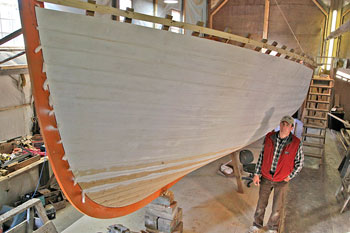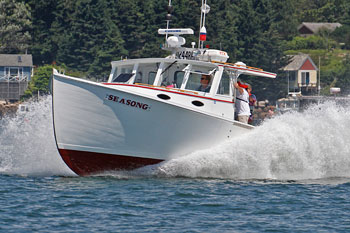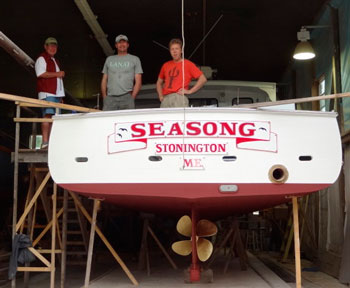Every Fisherman Has a Story to Tell and Every Story is Different: Stonington, Maine Fisherman Frank Gotwals, Part IV: 2004-2013

Frank Gotwals racing his recently launched Seasong at Stonington, Maine 2013. Gotwals runs a Cummins QSL9 which delivers 405 HP at 2100 RPM. Seasong is Gotwals’ third wood lobster boat. He helped build the last two with Peter Buxton. © Photo by Sam Murfitt
Although Stonington fisherman Frank Gotwals hinted to his stepson Jason McDonald that he’d like to build another boat, and admitted that they had joked about it from the time he had first built Seahawk, it took about seven years for the two to get serious about the possibility. Gotwals said McDonald, “Started making noises about wanting to have another boat and saying he’d kind of like to have [Seahawk].” Asked why in 2013, McDonald replied, “Because we built it, or he built it, and I helped. And I knew he might want to make another one, and if he did, I’d like that [first] one, just to keep it in the family.” Asked how he knew his stepfather might want to make another boat, McDonald said Gotwals had mentioned building another boat a few times. But McDonald added that he didn’t think his stepfather would actually go through with it unless he knew McDonald wanted the boat.
Despite McDonald’s interest in Seahawk, it took Gotwals a long time to decide to let his son buy his boat. (Gotwals always refers to McDonald as his son.) He said, “I really liked that boat and had planned on it being my last,” Besides being a big financial expenditure, the stress of putting a new boat together led Gotwals to take a long time to decide whether or not to give up the Seahawk. He said, “It was not until the fall of 2011 that Jason and I agreed that he would buy the Seahawk and I would build the new boat.” Despite the agreement, Gotwals continued to fish the Seahawk until December of 2012, a total of eight years.

Peter Buxton in his Stonington shop with Frank Gotwals’ boat Seasong. Planked, bunged, caulked and nearly primed Seasong is the second lobster boat Buxton designed and built for Gotwals. © Photo by Sam Murfitt
But long before buying the Seahawk, the stepson Gotwals raised as his own, had emulated his stepfather by becoming a lobster fisherman and joining the Stonington Co-op. In time co-op members elected McDonald to the co-op’s board of directors, where he served for 8 or 9 years with his stepfather. Then in 2009, McDonald, then 34, succeeded his stepfather as president, which says more than a little about Gotwals as a father and role model.
Bridges said of current president McDonald, “I haven’t heard anyone say anything bad against him. Nope. Not at all. They’re two nice guys.”
After selling the Seahawk, Gotwals needed a boat. So he and agreed to go ahead with the new boat in the fall of 2011 and they started working on Seasong in the winter of 2011/2012. The fisherman said, “We made some refinements in the hull including adding two feet to the length and changing the way the bottom was shaped.” After working with the 36-foot boat for eight years, He said, “I thought a little more platform space would be useful, and we thought it might gain a little fuel efficiency with the extra length and no change in width.” He said, “I didn’t want to lose the characteristics of Seahawk that I liked: the ease of steering, the performance in a following sea, so Pete tried to design with that in mind.”
And along with those points, Buxton said, “I tried to keep the sea-keeping abilities that I liked about the 36, but [I wanted to] get the bow to pick up just a little bit more in order to make her a little dryer. I also designed her to be more of a built-down model than a skeg boat. The 38 has a deeper rabbet line than the 36, which makes for an easier motion in a head sea.”
“I was after fuel efficiency as well,” Gotwals said, “and [Pete] seems to have done that with this design. The engine is a Cummins QSL9, which delivers 405 HP @ 2100 RPM. It’s a combination of the engine and the hull shape that leads to efficiency.

Just add water. The 38' wood Seasong waiting to slide down the ways at Peter Buxton’s boat shop in Stonington. Buxton photo
“This boat is heavier than Seahawk.” Gotwals noted, “Yet it moves through the water more easily. Because this engine develops its horsepower at a lower RPM than the one in the other boat,” he said,” I was able to use less reduction.
“The ratio on the drive or reduction gear on Seasong is 2 to 1,” he explained. “On the Seahawk it was 2.5 to 1 for the same size propeller. This [ratio] also has an impact on fuel consumption.” Gotwals stated, adding, “I think the changes we made in the new boat are successful.”
Although Seasong had not fully soaked up by the time this part of the profile went to press, Gotwals reported, in September, “She is already a very comfortable boat to work out of and will only get better.” He said it would probably be another year or two before she’d be fully soaked up. The cedar planks of wooden boats soak up a lot of seawater, he explained, adding that all that weight below the waterline acts as a stabilizing factor in rough conditions. “The rolling motion is less abrupt than in fiberglass boats,” he said, “at least according to wooden boat owners.” He added that according to his own experience, there is also less vibration and noise because the wood absorbs both. Sternmen Gotwals has worked on both fiberglass and wooden boats. He said that all have noted a significant difference in the motion of both types, with the advantage going to wooden boats for comfort.
Buxton quoted a friend and neighbor, shipwright Michael Warr, on soaking up: “A wooden boat is nothing but a bunch of boards screwed together until it soaks up. Then it becomes a kind of unit.”
After Seasong had been launched and Gotwals had fished with it, he e-mailed, “The boat is really a joy to work out of. It’ll be a couple of months before it really soaks up, but it’s comfortable already.”
Designer Buxton said of Gotwals, “He seems very happy with the boat, and I just couldn’t be happier myself. As a builder, there’s always something you look at and say, Oh, I wish I’d done that a little different. Or I’d changed this, or maybe done the bow different.” Then he stopped and said, “You know, something? I’m just not sure what I would change about this boat, I’m so happy with it. It’s dry. It goes easily through the water. It’s smooth. It’s quiet. It’s just lovely.”
To see an album of photos chronicling the building of Seasong, go to www.buxtonboats.com.
